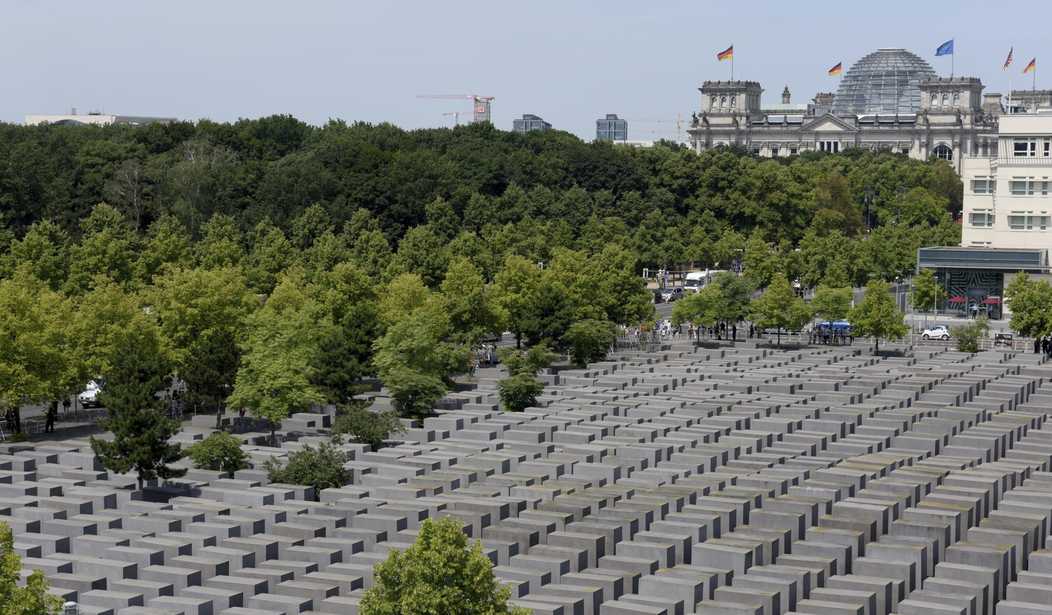If you’ve spent any amount of time walking around the downtown area of any German city, you’ve likely noticed a memorial commemorating the Holocaust. Perhaps the most notable of these memorials is the field of 2,711 gray concrete stones near the Brandenburg Gate in Berlin. Officially, this grim display is called the “Memorial to the Murdered Jews of Europe.”
It looks like a cemetery. It’s supposed to be the most solemn of places. Walking past it several times over the years, I’ve seen children running between the rows of stones, grinning tourists taking selfies, teenagers making out. I haven’t seen much in the way of solemnity. Oh, and there’s a good deal of littering.
But that’s not the main reason why the place rubs me the wrong way. It draws the wrong kind of attention to itself – namely, attention to its design, and thus to its designer – and thereby draw attention away from the people who are supposedly being memorialized. Look this thing up online and you’ll read that architect Peter Eisenman intended for the stones “to produce an uneasy, confusing atmosphere” and thus “represent a supposedly ordered system that has lost touch with human reason.” This isn’t a tribute to the dead of the Shoah; it’s a show-offy piece of self-conscious postmodern cleverness that’s all about itself.
The same goes for Berlin’s massive, imposing Jewish Museum, which I visited not long after it opened in 2001. The first thing I saw upon entering the museum was a large sign featuring the name of its architect, Daniel Libeskind. Indeed, I see online that now, at least, it’s officially known as “The Libeskind Building.”
The brochure I was handed when I visited “The Libeskind Building” was rife with pretentious jargon about its design. I don’t have the brochure anymore, but the description on the museum’s website will give you an idea: “The building zigzags with its titanium-zinc façade and features underground axes, angled walls, and bare concrete ‘voids’ without heat or air-conditioning….The building allows for many interpretations. For some people it brings to mind a broken Star of David; for others it is a bolt of lightning. Many people are left with a feeling of insecurity or disorientation.”
My own feeling, during my visit, was one of revulsion. Six million Jews were killed in the Holocaust, yet when I left the museum, the only name in my mind was that of Daniel Libeskind. The one thing that seemed to me to be a fitting – and genuinely moving – memorial was a modest display of items belonging to Holocaust victims: a pair of eyeglasses, baby shoes, a shawl.
Why, I wondered, wasn’t the whole museum like this? Wouldn’t it be more appropriate to find the simplest, most unprepossessing of buildings – a building that didn’t draw attention to itself – and fill it with humble items like these?
The answer, I’ve since realized, is that such a plain, discreet memorial wouldn’t be enough. The official German psyche demands more. In my recent novel, The Alhambra, the protagonist contemplates that field of 2,711 stones in Berlin:
“Look how sorry we are!” it proclaimed. But who was sorry? “Look, we remember!” it shouted. But who remembered? Could it be that the conception and construction, over the decades, of all these mammoth, gloomy reminders of the urgency of memory were actually part of a desperate effort to finally earn the right to forget? Were these monuments formed out of regret and remorse, or out of resentment?
These aren’t idle questions. Every observer of Germany knows that its officially prescribed attitude of perpetual atonement over the Holocaust coexists with an anti-Semitism that’s been on the rise for decades. These two phenomena are unquestionably linked – which is to say that the hostility of many Germans toward Jews is rooted in their awareness of their grandfathers’ or great-grandfathers’ wartime actions, their awareness that they’re expected to spend their lives professing guilt for these actions, and the fact that, in a country full of reminders of those actions, it’s impossible to escape this awareness.
How, after all, can a country that did what Germany did in the 1940s be psychologically healthy only three generations later? Henryk M. Broder, the German Jewish writer, put it this way in 1986: “The Germans will never forgive the Jews for Auschwitz.” It’s become a cliché that Germans love dead Jews – they just don’t care for living ones.
Six years ago I reviewed Tuvia Tenenbom’s eye-opening book I Sleep in Hitler’s Room: An American Jew Visits Germany. Tenenbom, I wrote, was “constantly exposed to rote expressions of sympathy for the victims of Auschwitz – and rote expressions of rage over Israel’s supposedly deplorable treatment of the Palestinians.”
Obviously, Germans enjoy equating Israel with Nazi Germany because it helps relieve their historical guilt. Germans will tell you that they’re resolved never to let “that” happen again – but they’ve managed to convince themselves that the group most in danger of being subjected to “that” in today’s Europe isn’t the Jews but the Muslims. Therefore, the best way to atone for what their ancestors did to Jews is to kowtow to Islam.
Hence, during his tour of Germany, Tenenbom meets a self-identified “feminist” and “peace activist” who, to further the image of Islam as a religion of peace and love, has planted a rose garden at a mosque. But as Tenenbom discovers, the woman doesn’t even know that “Islam” means “submission” and that Islam isn’t the most female-friendly of faiths.
It’s hard not to re-read Tenenbom’s anecdote without thinking of Angela Merkel, whose decision to admit a million unvetted Muslims into Germany may seem inexplicable to you and me but makes a perverse kind of sense if you step back and look at the psychopathology of the twenty-first-century Bundesrepublik. Merkel’s invitation is that rose garden at the mosque writ large.
Meanwhile, even as German authorities spend millions of euros on public reminders of Nazi genocide, they labor to dismiss or deep-six contemporary acts of anti-Semitism. As Benjamin Weinthal reported the other day, police in Ulm insisted that recent attacks on a local synagogue weren’t motivated by Jew-hatred.
The Simon Wiesenthal Center noted that this was far from the first time that officials in Germany had come to such a bizarre conclusion: not long ago, a court in Wuppertal actually “denied that throwing Molotov cocktails at synagogue in Wuppertal constitutes an antisemitic attack.” How can this be?
A recent report on anti-Semitism in Europe explained: the German government routinely categorizes synagogue attacks as “anti-Israeli, not anti-Semitic.” It’s a slippery way of avoiding an uncomfortable fact, and on the entire continent, apparently, it’s Germany alone that systematically practices this deception. Which is why it might be time for Germany to put an end to its phony posturing about its past evils and face up to its present ones.









Join the conversation as a VIP Member